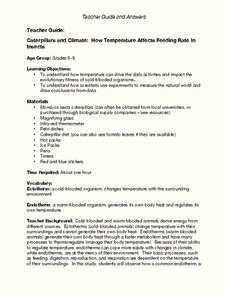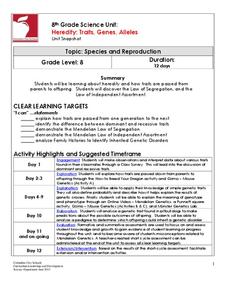Michigan Department of Education
Family Fundamentals for Summer Learning
Just because it's summertime, doesn't mean that learning has to stop. Support children with continuing to develop their reading fluency with this extensive collection of literacy activities.
Curated OER
Caterpillars and Climate: How Temperature Affects Feeding Rate In Insects
Do you eat more when you are hot or when you are cold? Young scientists observe the eating pace of two caterpillars at different temperatures. The differences in endotherm and ecotherm animals' ability to adjust to temperature change...
Pyro Innovations
Get into Shape
Shapes are so fun! Little ones explore, identify, and create shapes using tangrams or pattern blocks. The activity is intended to stimulate critical thinking while engaging learners through play and shape identification. Each child will...
Smarter Balanced
Food Waste and Food Access
Forty percent of food in the US goes uneaten while 14.5 percent of US households lack a secure supply of food. As part of the preparation for a performance task assessment, groups consider statistics such as these about food waste and...
PBS
Garden Grade 6 Area and Perimeter
Engage young mathematicians in applying their knowledge of area and perimeter with a fun geometry lesson. Through a series of problem solving exercises, children use their math knowledge to design different-sized garden...
Novelinks
Oedipus the King: Organizational Patterns
Designed for teachers of Sophocles' Oedipus the King, this packet provides information about themes and literary devices used in the play. Appropriate for first-time and veteran teachers of Sophocles' tragedy.
Classroom Law Project
Should we believe everything we read? Becoming a discerning consumer of media
Class members investigate the role media should play in a healthy democracy. As part of this study, groups analyze political advertising, use FactCheck to assess not only the veracity of but the persuasions techniques used in candidates'...
Columbus City Schools
Heredity: Traits, Genes, Alleles
If you knew people would pay extra for a bald dragon, could you pick which parents you should breed in order to get the highest number? The unit examines heredity and genetics through breeding dragons, mice, dogs, and tries to figure...
EngageNY
Real-World Positive and Negative Numbers and Zero II
Continuing from the previous lesson plan in the series, scholars learn to use positive and negative integers to describe real-world situations. In groups, they come up with their own situations for given positive and negative...
Curated OER
Volcanoes: First Grade Lesson Plans and Activities
Introduce young geologists to types of volcanoes during the pre-lab. First graders explore how different liquids flow with an experiment on viscosity to simulate how different types of lava flow. Next, they learn...
Curated OER
Volcanoes: Sixth Grade Lesson Plans and Activities
Bring a set of pre-lab, lab, and post-lab lesson plans on volcanoes to your earth science unit. Sixth graders explore the three types of volcanoes found on Earth, plot the specific locations of these volcanoes on a map, and...
Curated OER
Phonics lesson for -ar
First graders identify words associated with the -ar sound. They read sentences and compose a story that include words with the -ar sound. The assessment portion of lesson involves students in spelling words with the
-ar pattern.
Curated OER
Phonics lesson for "sh"
First graders identify words with the "sh" pattern. They participate in phonemic awareness, decoding, blending, spelling patterns, and dictation exercises. As the assessment portion of the lesson, they may write a story using words...
Curated OER
Graphing Population Around the World
Young scholars define specific vocabulary necessary for understanding population data. They collect, analyze, and interpret specific data. They utilize computer programs in order to create graphs of collected data.
Curated OER
On-Line Homework Help: An Ethical Dilemma
Young scholars use a visual thesaurus and Vocabgrabber to interpret a news article. In this vocabulary building and comprehension lesson, students analyze quotes from the article. Young scholars use the visual thesaurus and Vocabgrabber...
Curated OER
Prehistoric Native American Lesson Plan: Pictionary with the Past
Students participate in a vocabulary exercise at a website dedicated to Prehistoric Native Americans.
Curated OER
The Search for Character!
Fifth graders define character words, look for real-life examples of the traits "in action," and write an acrostic poem based on one of these qualities.
Alabama Learning Exchange
Looks Like Snow
Students listen to the teacher read the book, The Jacket I Wear in the Snow, and create vocabulary and graphic cards from the story.
Curated OER
History of Theory of Evolution
Students infer evolutionary relationships by comparing the physiological data or description. They write what they think would happen if a brown bear in the woods had an offspring that was white. Would this help the baby bear in its...
Curated OER
Belt-Abouts (Lesson 3)
Students discuss the importance of wearing seat belts every time they are in a car. After identifying new vocabulary, they review some of the excuses others use not to wear their seat belts. They give a survey to their family members...
Curated OER
What's the Chance?
Pupils study probability and statistics by conducting an experiment, recording their results, and sharing data with classmates.
Curated OER
Medical Terminology - Blood, Lymph, Immunity
In this medical word search worksheet, students identify and locate vocabulary terms related to specific medical terminology. There are 54 words located in the puzzle.
Curated OER
Spelling Strategies for Success
Students identify the meaning of the suffix "er" in given words and sort according to meaning. Students pair up for proofing of work, checking for correct sorting of words in categories of: no suffix, suffix that means "more," and...
Curated OER
Spelling Success; Vowel Sounds
There is a big difference between the words bit and bite. Learners begin to understand how to differentiate between short and long vowel sounds as they are given a word with a short vowel sound, and then are asked to add a letter to make...























